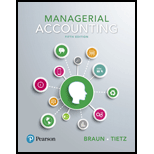
Calculate the
SUSTAINABILITY
Melford Containers currently uses a recycled plastic to make bottles for the food industry.
Current bottle production information:
The cost and time standards per batch of 10,000 bottles are as follows:
| Plastic 240 kilograms at $4.00 per kg |
| Direct labor 2.0 hours at $20.00 per hour |
The variable manufacturing
Proposed changes to bottle design and production process:
The container division manager is considering having both the bottle redesigned and the bottle production process reengineered so that the plastic usage would drop by 30% overall due both to generating less scrap in the manufacturing process and using less plastic in each bottle. In addition to decreasing the amount of plastic used in producing the bottles, the additional following benefits would be realized:
- a. Direct labor hours would be reduced by 20% because less scrap would be handled in the production process.
- b. Total estimated variable manufacturing overhead would be reduced by 10% because less scrap would need to be hauled away, less electricity would be used in the production process, and less inventory would need to be stocked.
Requirements
- 1. Calculate the standard cost per batch of 10,000 bottles using the current data (before the company makes any changes). Include direct materials, direct labor, and variable manufacturing overhead in the standard cost per unit.
- 2. Calculate the standard cost per batch of 10,000 bottles if the company makes the changes to the bottle design and production process so that less plastic is used. Include direct materials, direct labor, and variable manufacturing overhead in the standard cost per unit.
- 3. Calculate the cost savings per batch by comparing the standard cost per batch under each scenario (current versus proposed change). Assume that the total cost to implement the changes would be $106,400. How many batches of bottles would need to be produced after the changes to have the cost savings total equal the cost to make these changes?
- 4. What other benefits might arise from making this change to using less plastic in the manufacture of the bottles? Are there any risks? What would you recommend the company do?
Want to see the full answer?
Check out a sample textbook solution
Chapter 11 Solutions
Managerial Accounting, Student Value Edition (5th Edition)
 Cornerstones of Cost Management (Cornerstones Ser...AccountingISBN:9781305970663Author:Don R. Hansen, Maryanne M. MowenPublisher:Cengage Learning
Cornerstones of Cost Management (Cornerstones Ser...AccountingISBN:9781305970663Author:Don R. Hansen, Maryanne M. MowenPublisher:Cengage Learning Excel Applications for Accounting PrinciplesAccountingISBN:9781111581565Author:Gaylord N. SmithPublisher:Cengage Learning
Excel Applications for Accounting PrinciplesAccountingISBN:9781111581565Author:Gaylord N. SmithPublisher:Cengage Learning Managerial AccountingAccountingISBN:9781337912020Author:Carl Warren, Ph.d. Cma William B. TaylerPublisher:South-Western College Pub
Managerial AccountingAccountingISBN:9781337912020Author:Carl Warren, Ph.d. Cma William B. TaylerPublisher:South-Western College Pub Financial And Managerial AccountingAccountingISBN:9781337902663Author:WARREN, Carl S.Publisher:Cengage Learning,Principles of Accounting Volume 2AccountingISBN:9781947172609Author:OpenStaxPublisher:OpenStax College
Financial And Managerial AccountingAccountingISBN:9781337902663Author:WARREN, Carl S.Publisher:Cengage Learning,Principles of Accounting Volume 2AccountingISBN:9781947172609Author:OpenStaxPublisher:OpenStax College




